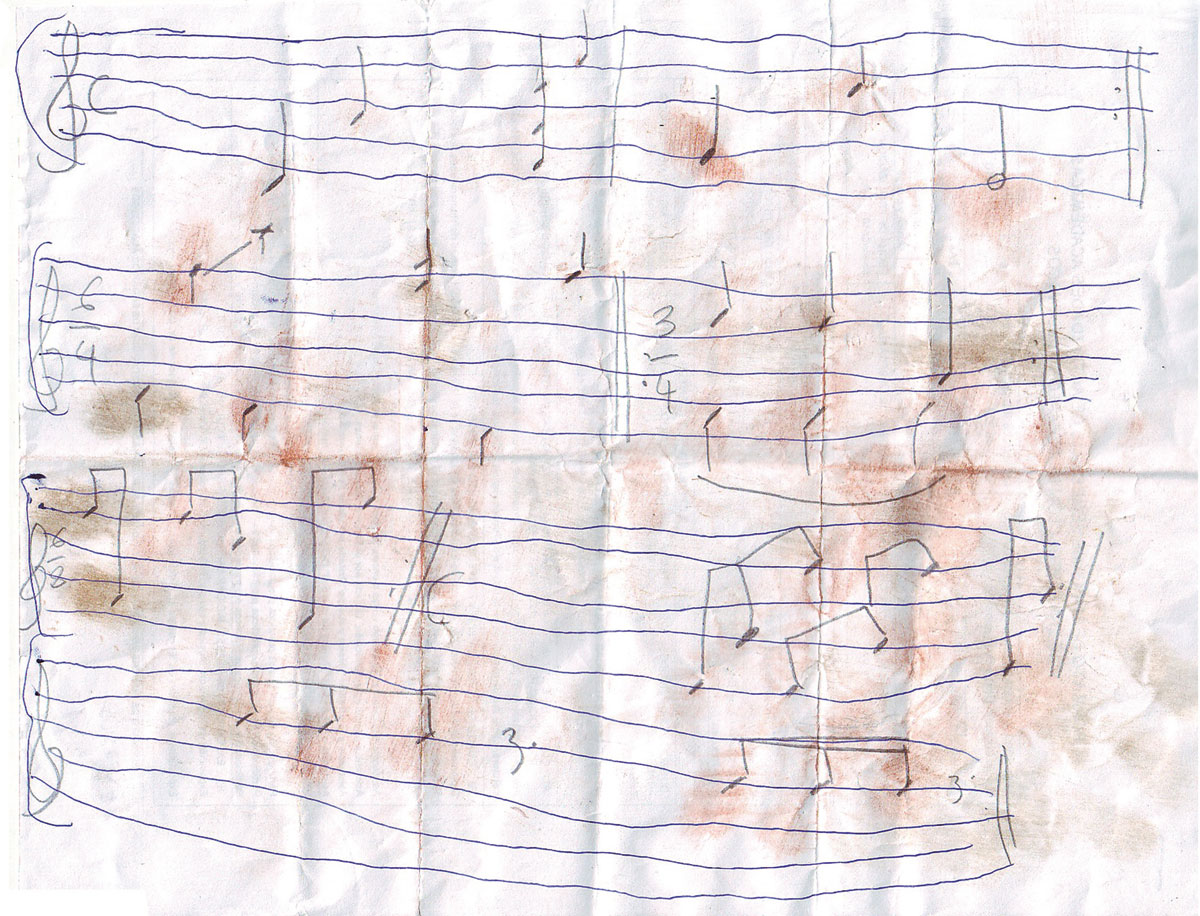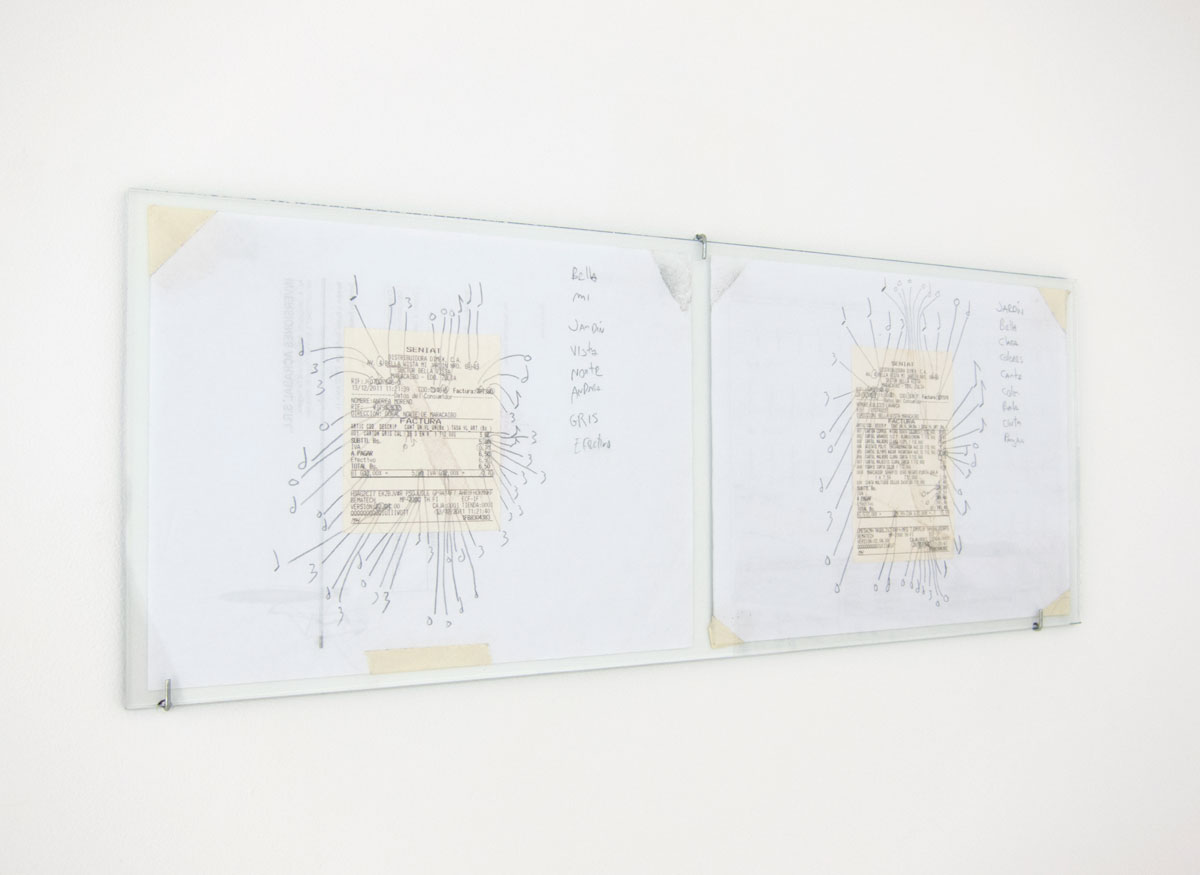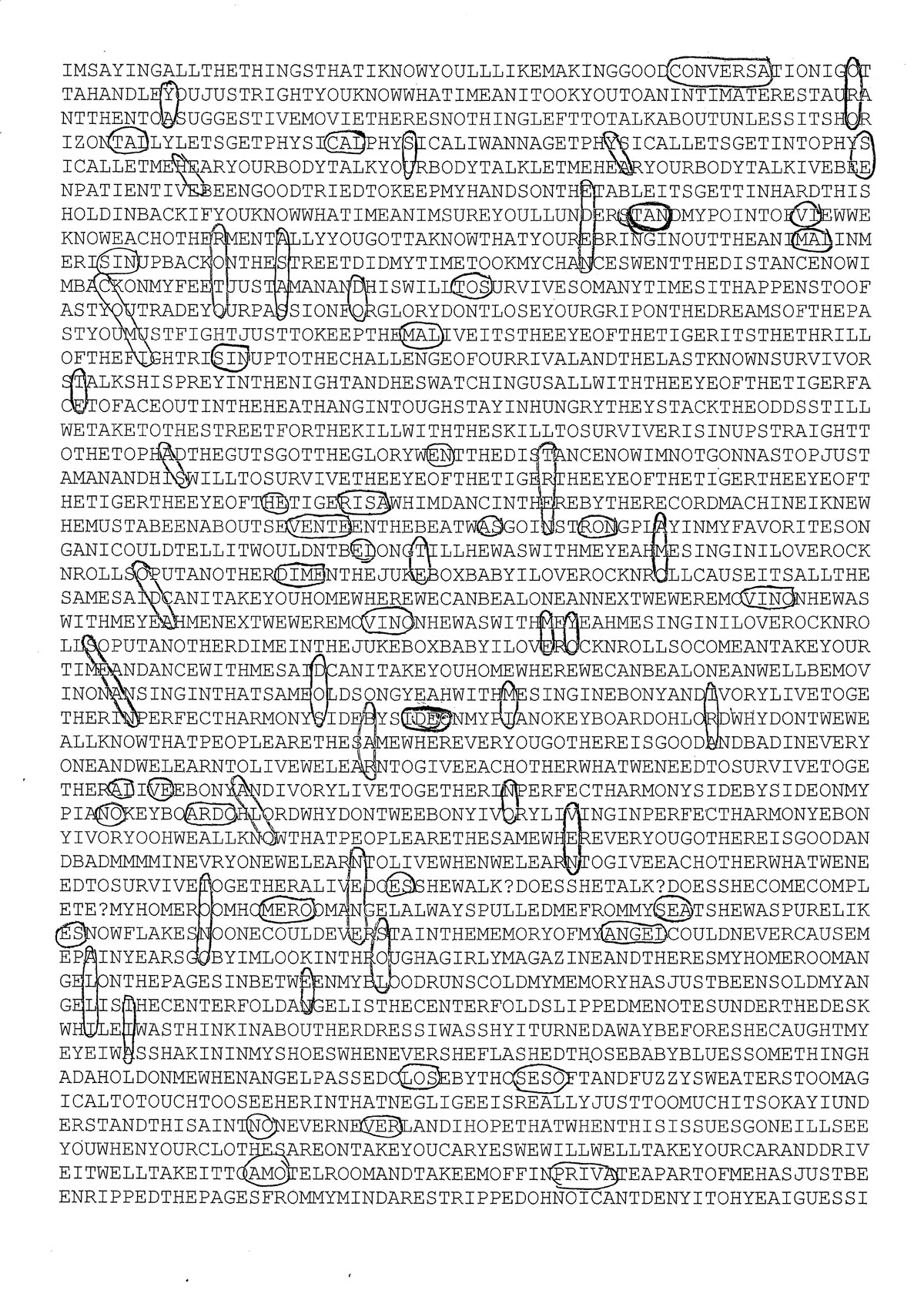I had few musician friends as a teenager. Although most of them played the guitar, their main interests were in painting, literature, cinema, or poetry. Being innovative, transgressive and original was a priority in our work in the Maracaibo of the nineties, but I always felt that, in each of their disciplines, they had more natural ways of doing it –I, as a musician, did not: playing fast or making people jump at a rock concert seemed to be the goals (failed by me).
I have always had the impression that the song is atrophied, compared to other forms of art. While «massive» works such as Chico Buarque’s Construção or Rubén Blades’s GBDC have opened new spaces, most people think of making songs for people to dance to, or for a radio circuit, or to remind them of another song on the radio. And that’s not wrong. I am concerned (among other things) with questioning the many neglected territories of the song, such as their direct relationship with the plastic / physical, or their relationship with other disciplines that go beyond an inspiration for a novel or video clip.
After having the idea of incorporating randomness into song (understood as music and lyrics together) in my head for years [1], I had the opportunity to do so thanks to an invitation by Ruth Auerbach and Juan Pablo Garza during the 2011 Velada de Santa Lucía.
Auerbach invited me to participate in the interdisciplinary exhibition she was curating in a house she’d been assigned. Here’s a fragment of the text I included as part of the montage of the piece:
«The main idea we worked on was landscape. It occurred to me to talk to the people of the house and ask them about landscapes from remote places that they always wanted to visit and never could. Mr. Daniel’s house, in my opinion, is an execution of this nostalgia.».
Mr. Daniel is a renowned karateist, national champion and long-time teacher, and disciple of another great master, Okinawa native Senzei Hiramatzu. On the yellow sign upon the entrance of the living room inhis house (old dojo) it read «Okinawa» in Japanese characters.

«The piece of paper you have in your hands is the origin of the music that (hopefully) you’re hearing,» read the reverse. I made five lines of pentagram paper and rubbed it through various parts of the house (the wall, the patio, the pipes, etc.). From the resulting marks, I took the notes on which I built the harmony and structured the song. Let me make it clear: I put the notes that I saw after arriving at my house on Tuesday, today I see others notes in the spots, but it’s like a Rorschach test –everyone sees something different.
For the lyrics, I put together words okinAGUA and saNta Lucía, and LAGUNA came out. The lyrics (I think) evoke a person who comes from (or goes to) a fight and reflects by watching the water. A possible landscape in Maracaibo or Okinawa.
The vocal melody, the rhythmic assignment of the notes on the scrubbed paper and the arrangements I made at will. These are the lyrics :
Saben las respuestas
Hacen las preguntas
“Todos los lugares ya son suyos”
Todas las miradas caen juntas
Y volver y perder. Nunca he visto lo que sé.
Ármame, húndeme. En fondo soy. Ahí brillan, brillan.
They know the answer
They ask the questions
«All the places are already yours»
All gazes fall together
And to come back and lose. I’ve never seen what I know.
Arm me, sink me. Deep inside I am. There they shine, shine.
After this experience, I began Mañana de diligencias (“Morning of Errands”), another attempt to originate a song from materiality and not from metaphysical places [2]. After experimenting with several materials that did not work (plastic, paper, and cardboard), I managed to fix a cloth with five straight lines (imitating the pentagram paper) on one of the tires of my car, and went out to run a couple of errands. On the way back, the cloth had a series of stains on the staff that could be interpreted as notes.

Now, what rhythmic figures do you assign to them? Easy: I used two receipts from my errands as tools, each number (excluding 3, 5, 6, 7 and 9, for not having correspondence with the rhythmic figures of the musical notation) would designate the rhythmic figure of each note, A round, a white 2 and so on.[3]

For the lyrics, I used exclusively words present in the receipts:
El gris y los colores,
Las cartas quieren
Jardín de mí, mi
Mi jardín.
Gris, cada, Cada
Para, Gris,
Clara y bella,
Gris, Mi, mi Jardín.
The gray and the colors,
The letters want
Garden of me, my
My garden.
Gray, Every, Every
To, Gray,
Clear and beautiful,
Gray, My, my Garden..
Driven by an invitation from Scrapped magazine [4] for an issue focused on the theme of Future Dinosaurs –things that were giant at the time but quickly disappeared– I worked on the piece “Memory and Success.” I decided to start with two elements: radio hits and the photocopier.
On one hand, I took the first four measures of the 5 Billboard hits of the month when I was born [5] (October 1982) and superimposed them on a pentagram [6], assigning different geometric figures to each song. Then, I copied that to a sheet and then copied that copy, and so on, until the notes had degraded to nothing. I entered all this information into Reason, a music software, and transcribed sound by sound the disappearance of each note: the more it had been erased, the smoother it sounded.

For lyrics, I put together the lyrics of the five songs (in English) and made a word search. I only used words (in Spanish) that I found there. I did the vocal melody without sticking to any method related to randomness. Here the result:
Sea el tren, sea Edén.
Solo es Oro, roto.
Sea el tren sea Edén
Solo es Vino, oro
¿Aló? Aló Aló
Vente
Aló aló aló
Ardo
Y su tono
Y su risa
Y mi tono
Y su ira
Dos. Y su amo. Y su vente.
Dos. Cal. Roto.
Be the train, be Eden.
It’s just gold, broken.
Whether the train is Eden
It’s only wine, gold
Hello? Hello Aló
Vente
Hello hello hello
I Burn
And its tone
And his laughter
And my tone
And his anger
Two. And his master. And its coming.
Two. Cal. Broken.

La partida del siglo (“The Game of the Century”) is a piece built on the registration codes from the chess game between Donald Byrne and Robert Fischer in 1954. As a child, I was browsing chess magazines in a bookstore and found it fascinating how anyone could get excited by reading such dense codification.
In chess coding, the letters A through H are used as parallels, and numbers 1 through 8 are used as meridians. In music, there is the encryption coding, which assigns the seven basic musical notes the letters A to G, and the numbers to the octave in which the note will be played. But I had one small problem: what to do with H? First I thought of turning it into a silence, but then I had a better idea: to make it a sustained Sol, like a step after the G, which is at the same time an alteration that, in the context of the minor (relative tonality to C major), refers to the minor harmonic scale. When singing the melody, I had to change some octave notes (which is common in the interpretation of songs), as well as to change it from its original tonality (C major) to a more comfortable one (G major).
There was still one question: What rhythmic figure should be assigned to each note? The answer was clear: Byrne played with white, Fischer with black, so Byrne’s notes would be white (they would last two measures) and Fischer’s notes would be black (one measure); this resulted in a song that sounds like a ¾ rhythmic pattern.
The 41 moves are represented in the lyrics, which consist of a series of bisyllabic words, where the consonant of each syllable corresponds to the piece played [7]. Of course, I had to –for some moves– resort to neologisms.
1-Coco
2-Papa
3-Caben
4-Pastora [8]
5-Arpa
6-Quepa
7-Quepa
8-Pecar
9-Tocar
10-Quebrar
11-Beca
12-Quinca
13-Pica
14-Barqui
15-Barca
16-Bata
17-Rabo
18-Bebo
19-Rasca
20-Rasca
21-Rasca
22-Rasca
23-Raspe
24-Quieto
25-Querca
26-Peto
27-Rencor
28-ToTo
29-Quebrar
30-Cabra
31-Coca
32-Quipe
33-Pepe
34-Carré
35-Robar
36-Rencor
37-Robar
38-Roba
39-Rencor
40-Rincón
41-Reto
Here is a transcript of the game:
1.Nf3 Nf6 2. c4 g6 3. Nc3 Bg7 4. d4 O-O 5. Bf4 d5 6. Qb3 dxc4 7. Qxc4 c6 8. e4 Nbd7 9. Rd1 Nb6 10. Qc5 Bg4 11. Bg5 Na4 12. Qa3 Nxa4 13. bxc3 Nxe4 14. Bxe7 Qb6 15. Bc4 Nxc3 16. Bc5 Rfe8+ 17. Kf1 Be6 18. Bxb6 Bxc4+ 19. Kg1 Ne2+ 20. Kf1 Nxd4+ 21. Kg1 Ne2+ 22. Kf1 Nc3+ 23. Kg1 axb6 24. Qb4 Ra4 25. Qxb6 Nxd1 26. h3 Rxa2 27. Kh2 Nxf2 28. Re1 Rxe1 29. Qd8+ Bf8 30. Nxe1 Bd5 31. Nf3 Ne4 32. Qb8 b5 33. h4 h5 34. Ne5 Kg7 35. Kg1 Bc5+ 36. Kf1 Ng3+ 37. Ke1 Bb4+ 38. Kd1 Bb3+ 39. Kc1 Ne2+ 40. Kb1 Nc3+ 41. Kc1 Rc2#
Though my initial intention with this project was only to produce songs, the tools I used to produce them were appealing to the curators / editors with whom I worked, making it an interdisciplinary project, and, as one dealer told me: «My love, I need something to sell. »
Throughout the process, I was keen on making a good song, one that I would like to listen to. Although the process of creation of each piece frames it within the contemporary discourse of the arts, I didn’t want to fall into producing a type of work in which the anecdote and narration were more important than the work itself. That might be why all the pieces have one element not controlled by the randomness. I think the work must defend itself.
Right now I’m working on an EP that will end the trilogy I started with Pavimento (2015), followed with Movimiento y otros relatos sobre el fin del mundo (2016) and will conclude in 2017 with Ulises Hadjis y otros relatos sobre mi nombre y mis cosas. Of the latter, I decided to share an unpolished track called Ulises (there will be one for each of my first and last names). The lyrics are based on this acrostic:
Una
Larga
Ilusión
Sostiene
Este
Sueño
A
Long
Delusion
Holds
This
Dream
The music sheet for the guitar imitates the graphic of the name.

The brief lyrics, based on the acrostic, reads:
Puedo despertar muriendo. ¿Puedes ver al tiempo?
I can wake up dying. Can you see the time?
Notes:
[1] Randomness is a concept used extensively by composers such as John Cage, and even within the song format, there are famous anecdotes of the use of randomness at specific times in the Beatles or David Bowie. However, these are isolated cases and there is no tradition of this practice being widespread within the format.
[2] Many composers, in talking about their creative process, seem to connect with an immaterial entity, from the «muse» to the «inspiration», or even God.
[3] Which is a standard in musical language.
[4] American magazine of art published in the city of New York since 2012.
[5] Eye of the Tiger – Survivor, Ebony and Ivory – Paul McCartney & Stevie Wonder, I love Rock and roll -Joan Jett, Physical – Olivia Newton-John, and Centerfold – The J. Geils Band.
[6] ransposing them all to C major.
.
[7] Pawns: P, Alfiles: B (for Bishop in English, needed a consonant), Towers: T, Horses: C, King: R, Queen: Q (by Queen in English, to differentiate it from the king).
[8] It is not bisyllabic because it refers to castling.
About the Artist:
Ulises Hadjis is a Venezuelan singer-songwriter currently based in Mexico City. His second album Cosas Perdidas (2012) received three Latin Grammy nominations in the categories of New Best Artist, Best Alternative Album, and Best Rock Song. His songs have a particular identity with touches of pop, rock, indie and folk, and intriguing lyrics, thanks to his sensitivity and studies of psychoanalysis, which he began after finishing his Master’s degree in Philosophy.








